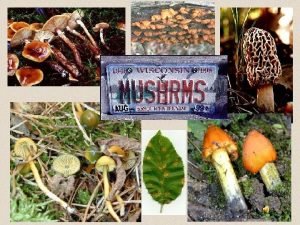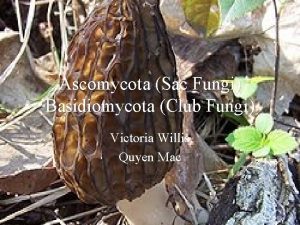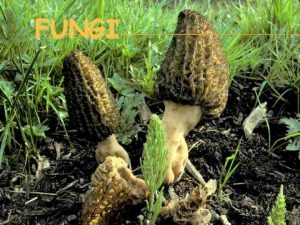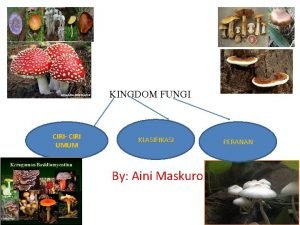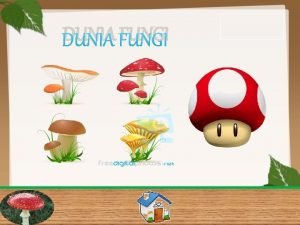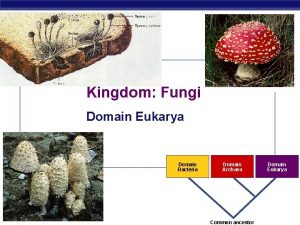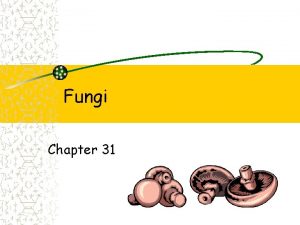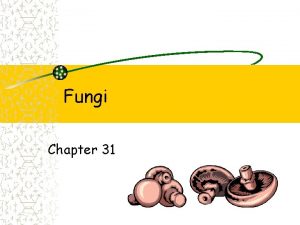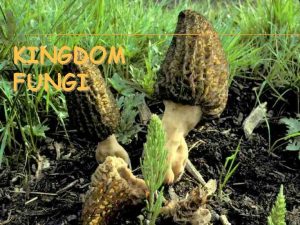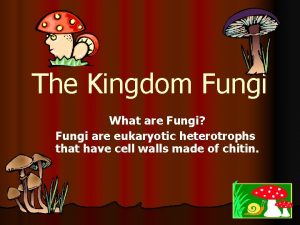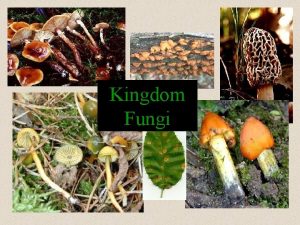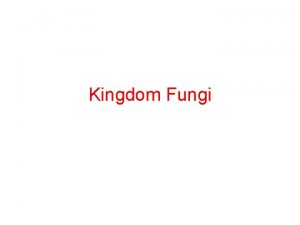Overview u u u Kingdom Fungi differ in












- Slides: 12

Overview u u u Kingdom Fungi differ in form, size and color Oldest fossils are 450500 million years old Most grow best in moist, warm environments between 20 -30°C Most are multicellular (except yeasts) Heterotrophic, Decomposers Phylum is replaced with divisions http: //www. naturegrid. org. uk/biodiv ersity/crypfungi. html

Structure of a Fungi Hyphae – threadlike filaments which develop from fungal spores u Hyphae elongate at their tips and branch extensively to form a network of filaments called a mycelium. u Mycelium – (many types) some anchor the fungus, others invade the food source, or function as a reproductive structure u

Plants versus Fungi Like plants, they grow anchored in the soil and have cell walls. u Unlike plants, which have cell walls made of cellulose, fungi use a complex carbohydrate called chitin. u Chitin gives the fungal cell walls both strength and flexibility. u

Fungal Feeding u There are 3 ways heterotrophic Fungi feed: – Saprophytes are decomposers and feed on waste or dead organic material. – Mutualists live in a symbiotic relationship with another organism like an alga. – Parasites absorb nutrients from the living cells of their hosts u Specialized hyphae called haustoria

Fungal Reproduction u u One important criterion for classifying fungi into divisions is their patterns of reproduction Fragmentation – pieces of hyphae broken off a mycelium grow into new mycelia. Unicellular fungi (yeast) reproduce by asexual budding. Most fungi produce spores: specialized mycelium called sporangium. – Protects the spores before being released and keeps them moist

Advantage of Spores u u Protection from harm (sporangium) Small & lightweight, can be dispersed by wind, water, animals – Wind can disperse a spore 100 s of kilometers. Produce a large number of spores at one time – A puffball 23 cm in circumference produces about 1 Trillion spores! – Greater survival in numbers Fungi can produce 2 types of spores: – Mitosis (asexual phase) – Meiosis (sexual phase)

Common Molds Members of Zygomycota u Called “Pin molds” or “sugar molds” u Attack breads & fruits u 900 species u Root-like hyphae called rhizoids penetrate the bread’s surface, stem-like hyphae called stolons run along the bread u

Sac Fungi Ascomycotes – have ascus, reproductive structure that contains spores u 30, 000 species u Includes: cup fungi, yeast, morels, truffles u

Club Fungi u u u Basidomycotes: have club-shaped hyphae (basidia) which produce basidospores 25, 000 species Include: puffballs, shelf fungus, mushrooms

Imperfect Fungi u u Deuteromycotes: reproduce asexually 25, 000 species Species are varied, can not be assigned to other phyla Includes penicillin, blue cheese veins

A unique fungi: Lichen u u u Lichen – a symbiotic association between a fungus & a green alga Only need light, air, minerals to grow Awesome case of Mutualism… – The photosynthetic alga provides the food for the organism – The fungus provides the alga with water, minerals and protects it from the environment.

Not So Great Fungi
 Kingdom plantae characteristics
Kingdom plantae characteristics Kingdom of protist
Kingdom of protist Protista mobility
Protista mobility Nnn ruled
Nnn ruled Old kingdom middle kingdom new kingdom
Old kingdom middle kingdom new kingdom Capital of egypt during the old kingdom
Capital of egypt during the old kingdom Old kingdom middle kingdom new kingdom
Old kingdom middle kingdom new kingdom Are fungi eukaryotic
Are fungi eukaryotic Examples of club fungi
Examples of club fungi Basidiomycota rusts and smuts
Basidiomycota rusts and smuts Fragmentasi miselium
Fragmentasi miselium Peta konsep fungi lengkap
Peta konsep fungi lengkap Domain eukarya kingdom fungi
Domain eukarya kingdom fungi







